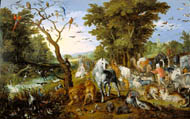Grades/Level: Lower Elementary (K–2), Upper Elementary (3–5), Middle School (6–8), High School (9–12)
Subjects: Visual Arts, English–Language Arts
Time Required: Short Activity
20 minutes
Author: J. Paul Getty Museum Education Staff
|
 |
 |
1. Ask students to speculate on how much time they think they might spend, on average, looking at a work of art. Record their responses and discuss the factors they believe affect the amount of time they spend looking. Ask students to speculate on how much time they think adults spend, on average, looking at a work of art. After students have answered, explain that the average amount of time people spend looking at one object in a museum is less than half a minute. Ask students if thirty seconds is enough time to spend with a work of art. Why or why not? Try the following experiment in small groups to test their answers.
2. Direct students to look at a work of art (in the classroom, use a poster or transparency) for thirty seconds. At the thirty-second mark, ask everyone to turn around and face away from the work of art (in the classroom, turn off projector or remove the poster).
3. Without looking back at the work of art, ask students to use their memories to answer questions based on their observations. You might ask the following questions:
• How many (objects, people, etc.) are in the work of art?
• How would you describe them?
• How is each one dressed?
• What kind of setting is depicted?
• Are there any animals in the work of art?
• How would you describe them?
• What is the subject of the work of art?
Chart the words that students come up with to create a word bank. Optional: Create categories, such as types of objects (for example, fruit), and then list the types they saw in the work of art.
4. With students' interests piqued, have them look again at the work of art. Guide the students through a careful re-examination. Ask them how they would refine their "looking." Ask if there is anything on the list that isn't actually in the work of art. Explain that sometimes we believe we saw something when we didn't; or sometimes we might recall different colors than those actually used in the work of art. Encourage students to speculate about what is being communicated. Ask them to explain how the detailed observation allowed them to determine what the work of art depicts.
5. Ask students to consider how much longer they spent looking at the work of art the second time, and to explain their reactions to the work. Was their initial glance enough? Ask students if discussing and comparing observations with other people was helpful in determining the meaning in a work of art. Have the students explain their answers.
6. Ask students to build definitions from the charted vocabulary. Have them look up unfamiliar words or define them as a class.
|
 |
 |
 |
| The Entry of the Animals into Noah's Art, Jan Breughel the Elder, 1613 |
 |
|

